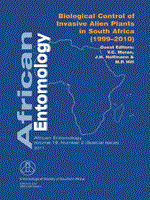Hakea sericea Schrad. & J.C. Wendl. and Hakea gibbosa (Sm.) Cav. (Proteaceae), are small trees or shrubs that originate from Australia. Hakea sericea has become highly invasive and problematic in South Africa while H. gibbosa is less widespread and abundant but nevertheless problematic. Biological control against H. sericea started in 1970 with the release of two seed-attacking insects, a seed-feeding weevil, Erytenna consputa Pascoe (Coleoptera: Curculionidae), and a seed-moth, Carposina autologa Meyrick (Lepidoptera: Carposinidae). Both of these agents, together with an indigenous fungus, Colletotrichum acutatum J.H. Simmonds f.sp. hakeae Lubbe, Denman, P.F. Cannon, J.Z. Groenew., Lampr. & Crous (Incertae sedis: Glomerellaceae), and manual clearing have reduced the abundance, and possibly the invasiveness, of H. sericea, but large infestations still persist in the coastal mountains of the Cape Floral Region in the Western and Eastern Cape provinces of South Africa. The release in 1979 of a weevil, Cydmaea binotata Lea (Coleoptera: Curculionidae), which bores in the terminal shoots and young needles of H. sericea has had a negligible effect. To enhance the levels of biological control, two new agents, a stem-boring beetle, Aphanasium australe (Boisduval) (Coleoptera: Cerambycidae), and a flowerbud feeder, Dicomada rufa Blackburn (Coleoptera: Curculionidae), were released in 2001 and 2006, respectively. The focus in this review is on progress since 1999 with the biological control and management of H. sericea. Releases of E. consputa and A. australe on H. gibbosa have met with limited success, the reasons for which are also reviewed.
BioOne.org will be down briefly for maintenance on 17 December 2024 between 18:00-22:00 Pacific Time US. We apologize for any inconvenience.
How to translate text using browser tools
1 August 2011
Biological Control of Hakea sericea Schrad. & J.C.Wendl. and Hakea gibbosa (Sm.) Cav. (Proteaceae) in South Africa
A.J. Gordon,
A. Fourie
ACCESS THE FULL ARTICLE
It is not available for individual sale.
This article is only available to subscribers.
It is not available for individual sale.
It is not available for individual sale.

African Entomology
Vol. 19 • No. 2
August 2011
Vol. 19 • No. 2
August 2011
Aphanasium australe
Cape Floral Region
Carposina autologa
Colletotrichum acutatum
conservation
Dicomada rufa
Erytenna consputa




